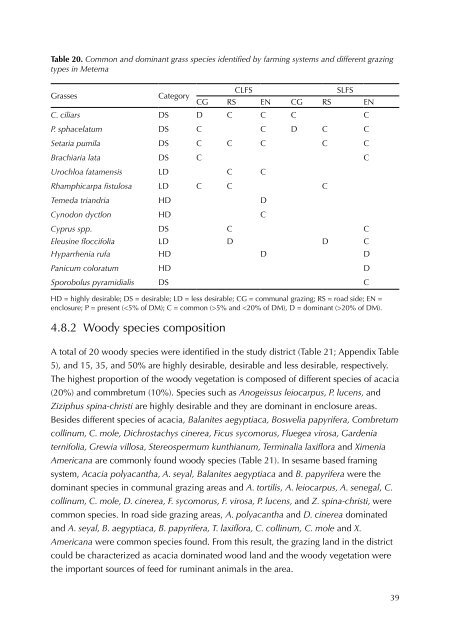Rangeland condition and feed resources in Metema District, North ...
Rangeland condition and feed resources in Metema District, North ...
Rangeland condition and feed resources in Metema District, North ...
Create successful ePaper yourself
Turn your PDF publications into a flip-book with our unique Google optimized e-Paper software.
Table 20. Common <strong>and</strong> dom<strong>in</strong>ant grass species identified by farm<strong>in</strong>g systems <strong>and</strong> different graz<strong>in</strong>g<br />
types <strong>in</strong> <strong>Metema</strong><br />
Grasses<br />
Category<br />
CLFS<br />
SLFS<br />
CG RS EN CG RS EN<br />
C. ciliars DS D C C C C<br />
P. sphacelatum DS C C D C C<br />
Setaria pumila DS C C C C C<br />
Brachiaria lata DS C C<br />
Urochloa fatamensis LD C C<br />
Rhamphicarpa fistulosa LD C C C<br />
Temeda tri<strong>and</strong>ria HD D<br />
Cynodon dyctlon HD C<br />
Cyprus spp. DS C C<br />
Eleus<strong>in</strong>e floccifolia LD D D C<br />
Hyparrhenia rufa HD D D<br />
Panicum coloratum HD D<br />
Sporobolus pyramidialis DS C<br />
HD = highly desirable; DS = desirable; LD = less desirable; CG = communal graz<strong>in</strong>g; RS = road side; EN =<br />
enclosure; P = present (5% <strong>and</strong> 20% of DM).<br />
4.8.2 Woody species composition<br />
A total of 20 woody species were identified <strong>in</strong> the study district (Table 21; Appendix Table<br />
5), <strong>and</strong> 15, 35, <strong>and</strong> 50% are highly desirable, desirable <strong>and</strong> less desirable, respectively.<br />
The highest proportion of the woody vegetation is composed of different species of acacia<br />
(20%) <strong>and</strong> commbretum (10%). Species such as Anogeissus leiocarpus, P. lucens, <strong>and</strong><br />
Ziziphus sp<strong>in</strong>a-christi are highly desirable <strong>and</strong> they are dom<strong>in</strong>ant <strong>in</strong> enclosure areas.<br />
Besides different species of acacia, Balanites aegyptiaca, Boswelia papyrifera, Combretum<br />
coll<strong>in</strong>um, C. mole, Dichrostachys c<strong>in</strong>erea, Ficus sycomorus, Fluegea virosa, Gardenia<br />
ternifolia, Grewia villosa, Stereospermum kunthianum, Term<strong>in</strong>alia laxiflora <strong>and</strong> Ximenia<br />
Americana are commonly found woody species (Table 21). In sesame based fram<strong>in</strong>g<br />
system, Acacia polyacantha, A. seyal, Balanites aegyptiaca <strong>and</strong> B. papyrifera were the<br />
dom<strong>in</strong>ant species <strong>in</strong> communal graz<strong>in</strong>g areas <strong>and</strong> A. tortilis, A. leiocarpus, A. senegal, C.<br />
coll<strong>in</strong>um, C. mole, D. c<strong>in</strong>erea, F. sycomorus, F. virosa, P. lucens, <strong>and</strong> Z. sp<strong>in</strong>a-christi, were<br />
common species. In road side graz<strong>in</strong>g areas, A. polyacantha <strong>and</strong> D. c<strong>in</strong>erea dom<strong>in</strong>ated<br />
<strong>and</strong> A. seyal, B. aegyptiaca, B. papyrifera, T. laxiflora, C. coll<strong>in</strong>um, C. mole <strong>and</strong> X.<br />
Americana were common species found. From this result, the graz<strong>in</strong>g l<strong>and</strong> <strong>in</strong> the district<br />
could be characterized as acacia dom<strong>in</strong>ated wood l<strong>and</strong> <strong>and</strong> the woody vegetation were<br />
the important sources of <strong>feed</strong> for rum<strong>in</strong>ant animals <strong>in</strong> the area.<br />
39

















